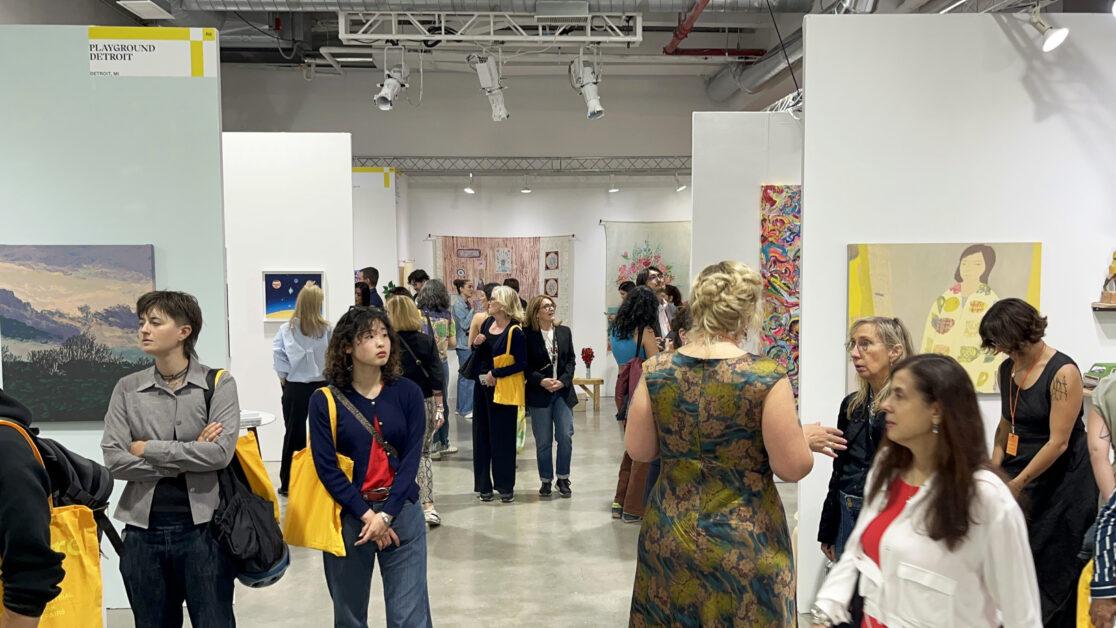In early May 2025, as the city buzzed with the glamour of the Met Gala and New Yorkers strolled the streets in cutting-edge fashion, a sense of luxury and celebration filled the air. This special week, when major art fairs such as Frieze New York, TEFAF, INDEPENDENT, and NADA converge across the city, offers an immersive and elevated experience simply by being there.
In the heart of Chelsea’s art district, the 2025 edition of Future Fair took place at Chelsea Industrial (535 W 28th Street). As a platform for rising galleries, the fair gathers curators, collectors, and art critics from around the world and is now regarded as one of the most important launchpads for the next generation of international contemporary art.
What is Future Fair?
Launched in 2020, Future Fair has rapidly grown into a curated fair that values selectivity, equity, and dialogue. Far from a traditional sales venue, it encourages collaboration among exhibitors and is guided by community-driven standards. Today, it enjoys both critical acclaim and international prestige. For its 2025 edition, 67 galleries from around the world were selected—among them, GOCA (Gallery of Contemporary Art) by Garde was the sole representative from Japan.
GOCA’s Challenge: Neo Japanese Pulse
GOCA is a New York–based gallery with a mission to showcase the value of Japanese and Asian artists on the global stage. At this year’s Future Fair, it presented a dual exhibition themed Neo Japanese Pulse: Reimagining a Cultural Loop, featuring works by Aya Kawata and Yuta Okuda.
The exhibition explored a re-interpretation of Japonisme—the wave of fascination with Japanese art that swept through Europe in the late 19th century. Japanese culture, once imported as a curiosity from the East, flowed into Europe and later to the United States throughout the 20th century. In the postmodern era, this trajectory reversed: Japanese culture that had evolved in the West began to re-enter Japan in new forms, creating a cyclical cultural phenomenon. Within this loop, Japanese artistic expression has undergone its own “Galápagos-style evolution.” Neo Japanese Pulse presented how contemporary Japanese artists are fusing tradition with modernity to redefine aesthetic expression on the world stage.
Aya Kawata: Delicate Grids at the Intersection of Neuroscience and Textiles
Aya Kawata draws on traditional Japanese textile techniques while exploring the intersection of visual illusion and cognitive science. Influenced by her neuroscientist father, her work invents a beauty found in control and misalignment within visual experience. Her abstract grid compositions blend craft and intellect to create a soft disorientation and deep immersion. Her practice introduces a new frontier in art history—particularly Western traditions of illusionism—through the uncharted union of science and craft.
Yuta Okuda: A Fusion of Floral Energy and Emotional Resonance
In contrast, Yuta Okuda is known for his vibrant, intricate floral works built from vivid color and precise linework. Combining London fashion culture with Japanese sensibility, he captures the interplay of chance and intention to create new forms of visual life. Beneath the explosion of color lies a core of universal human emotions: gratitude, connection, and vitality. His works offer a contemporary reinterpretation of kacho-ga (traditional bird-and-flower painting), merging beauty with spiritual expression.
International Reception and Strategic Impact
From the VIP preview onward, GOCA’s booth attracted key figures from the international art world, including curators from major New York museums, directors of global art fairs and institutions, cultural advisors, diplomats, consulate cultural officials, top-tier art media editors, market insiders, and, of course, collectors and art acquisition directors. Every booth at Future Fair buzzed with energy, including those from Asia, Africa, and across the U.S., with engaged visitors photographing works and conversing with gallerists. The sheer number of curators and collectors in attendance underscored the high level of curation and relevance of the fair itself.
Kawata’s work received praise for “bridging Eastern delicacy with scientific reasoning,” while Okuda’s was noted for “a return to primal beauty infused with futuristic color sensibility.” Multiple sales and exhibition offers followed. Most importantly, GOCA’s curatorial concept—rather than exporting culture in one direction, it embraces reinterpretation through global cultural circulation—was particularly well received in today’s diversity-conscious art world.
In Conclusion – Reframing “Japan”
Future Fair is more than just another art fair. It is an intellectual testing ground for reorganizing the boundaries between nations, markets, and cultural centers. Neo Japanese Pulse, as presented by GOCA, was not a display of Japan as it is, but an invitation to consider how culture transforms and circulates—an introduction to new forms of Japanese identity in art. That we were able to lay the foundation for this message from a small corner of Chelsea feels deeply significant. It marks the beginning of our voyage, and GOCA looks forward to continuing the dialogue on where Japan’s next artistic pulse may lead within the international art scene.

Future Fair 2025 – Overview
Dates: May 7 (Wed, VIP Preview) – May 10 (Sat), 2025
Venue: Chelsea Industrial (535 W 28th St, New York, NY 10001)
Participating Galleries: 67
Written by local correspondent Kenta Ichinose (GOCA Curator)




Pingback: GOCA by Garde – Inside GARDE’s New York Art Space and Its Latest Showcase - Garde Design Magazine
Pingback: ข่าวสารฟุตบอล
Pingback: นำเข้าพัดลม มอเตอร์